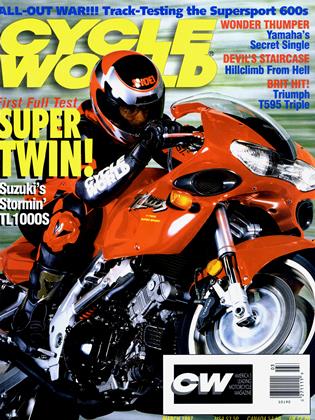The Triple Threat
The Japanese aren’t the only ones gunning for the 916
SUZUKI’S TL1000 AND HONDA’S VTR1000 clearly are out for Italian blood, and now Triumph wants in. The new T595 Daytona Triple, like the Japanese sport-Twins, has its sights set on Ducati’s 916 as primary target in the sporttbike wars.
The T595 is more than a replacement for the existing Daytona 900. This time, engineers made a conscious decision to build a machine capable of challenging the 916. After a fair bit of smooth talking, I persuaded Triumph
officials to let me sample a pre-production copy of their all-new, boundarydestroying supersport.
As you straddle the saddle, the riding position comes as a surprise: It’s not instantly comfortable. Unlike the 916, the T595 has a wide gas tank that spreads your legs like a giant wishbone. Indeed, the only time the perch feels right is when you’re in a full-race crouch. Triumph claims the seat is not yet finalized-two others are currently on trial. The seat-to-footpeg relationship is fairly natural, though, and grounding the latter takes a fair pace.
At the other end, you’ve got a sporty set of aluminum clip-ons. They’re mounted at a reasonable height, but the position and shape of the aforementioned gas tank makes them feel awkward most of the time. To be fair, though, you can’t expect absolute rider comfort from a bike that’s expected to be nipping at the 916’s heels.
Thumb the starter button and the engine jumps to life. Designed with help from Lotus Engineering, the inline-Three displaces 955cc via a 79 x 65mm bore and stroke. Compression ratio is 11.2:1. All this translates to a claimed 128 horsepower at 10,200 rpm and 74 foot-pounds of torque at 8500 rpm.
From 4000 rpm up, the engine pulls like a freight train. The powerband is beautifully predictable, and the transition from around-town torque to hooligan horsepower is barely noticeable. As one would expect from a bike equipped with computerized fdel injection, throttle response is unrivalled. Only the slightest dip of the clutch is needed along with a vote of encouragement from the throttle to hoist the front hoop smoothly into the air.
Structurally, the T595 certainly has it goin’ on. The engine is a stressed member of the sexy alloy perimeter frame, which is said to weigh less than Honda’s twinspar CBR900RR unit. The conventional front end exudes the same stability as a properly setup Kawasaki ZX-7R. (Word has it, Showa
spent considerable time with Triumph in the U.S. getting the fork just right.) The single-sided swingarm rear suspension is equally well controlled, firm yet compliant, a trait previous Triumphs struggle to match. Heeled over, the bike tracks with exceptional clarity, holds a tight line and responds without drama to subtle steering inputs.
The front brakes consist of 12.6-inch discs gripped by four-pot Nissin calipers. Unfortunately, Triumph’s ace factory testers had been caning the bike before I got to it and had cooked the pads. What a disappointment. Rumor has it the anchors are awesome.
There is one area where the 916 Ducati has definitely been left behind: price. Ducati couldn’t dream of producing a bike like the 595 with equal materials and workmanship quality for under 1 1 big ones. Well, they could, but they’d lose a ton of money over it, especially in development costs. Then, perhaps they would find themselves in deep financial doo-doo, be bought out by an American company and floated on the stock exchange. Hey, hang on a minute... -Simon Hammerson
Simon Hammerson is a staff writer for Fast Bikes magazine in England.
 View Full Issue
View Full Issue
More From This Issue
-
 Up Front
Up FrontThe Hopwood Chronicles
March 1997 By David Edwards -
 Leanings
LeaningsHow Many Bikes Do You Really Need?
March 1997 By Peter Egan -
 TDC
TDCPractical Men
March 1997 By Kevin Cameron -
 Letters
LettersLetters
March 1997 -
 Roundup
RoundupYamaha Shows Wonder Thumper!
March 1997 By Steve Anderson -
 Roundup
RoundupTraction Calling
March 1997 By Don Canet





